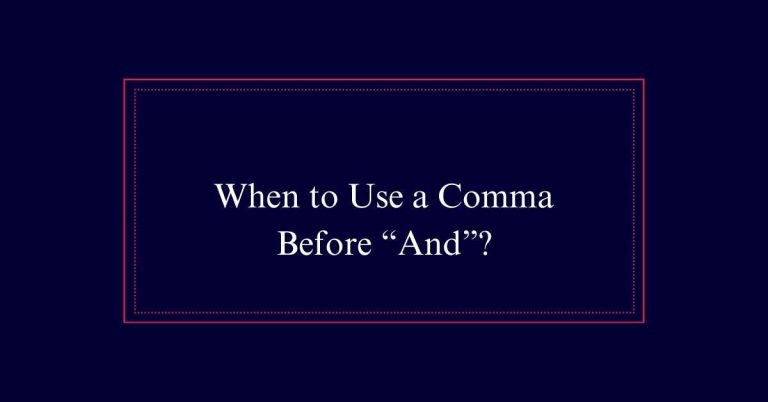Comma Between Subject and Verb
Inserting a comma between the subject and verb is grammatically incorrect and disrupts sentence flow. This mistake often stems from natural speech patterns, where pauses might seem necessary. However, in writing, such commas cause confusion and interrupt clarity. Proper comma placement is essential for readability and maintaining professional writing standards.
Importance of Proper Comma Usage
Ensuring proper comma usage is essential for maintaining sentence clarity and flow.
Commas play a pivotal role in structuring sentences correctly and ensuring they are understandable. They should not separate the subject from the verb, which can create unnecessary pauses and confuse readers.
Proper comma placement helps in forming grammatically correct sentences, enhancing the overall readability of the text. It ensures that the intended meaning is conveyed without ambiguity.
Incorrect comma usage can disrupt the natural rhythm of reading and lead to misinterpretation. Hence, understanding and applying correct comma rules is vital for effective writing.
Common Misconceptions
Many writers mistakenly believe that inserting a comma between the subject and verb is correct. This misconception often arises from the natural pauses in oral speech patterns, leading writers to mimic these pauses in their writing.
However, inserting a comma in this position disrupts the grammatical structure and clarity of the sentence. Complex or lengthy subjects can also tempt writers to insert unnecessary commas, mistakenly thinking it improves readability. Instead, this practice creates awkward sentence flow and reduces coherence.
Long and Complex Subjects
Long and complex subjects often tempt writers to insert unnecessary commas between the subject and verb. This common mistake stems from the perceived need to break up lengthy or intricate subject phrases for readability.
However, adding a comma in such instances can disrupt the natural flow and clarity of a sentence. For example, in the sentence ‘The committee, composed of several experts in various fields, has reached a consensus,’ the comma after ‘committee’ is unnecessary and incorrect.

Writers must remember that the subject, regardless of its length or complexity, should remain unseparated from its verb by a comma.
Correct Comma Placement
Correct comma placement is crucial for maintaining the clarity and coherence of sentences. Misplacing a comma, especially between a subject and its verb, can disrupt the sentence flow and confuse readers.
To guarantee proper comma usage, consider these key points:
- Avoid unnecessary pauses: Do not insert a comma between the subject and verb, as it creates an awkward break.
- Maintain sentence structure: Properly structured sentences without misplaced commas are easier to read and understand.
- Follow grammatical rules: Adhering to standard comma guidelines helps convey the intended meaning clearly.
Examples of Correct Usage
To illustrate proper comma placement, consider the following examples. Ensuring that commas do not separate the subject from the verb is important for maintaining clarity and readability in sentences. Below are some examples demonstrating correct comma usage:
| Incorrect Usage | Correct Usage | Explanation |
|---|---|---|
| My friend, Cleo, is a wonderful singer. | My friend Cleo is a wonderful singer. | No comma between ‘friend’ and ‘Cleo’ |
| The car, that is parked, belongs to Joe. | The car that is parked belongs to Joe. | No commas within the restrictive clause |
| Moving through snow, is challenging. | Moving through snow is challenging. | No comma between subject and verb |
| Her smile, which is lovely, brightens my day. | Her smile, which is lovely, brightens my day. | Non-restrictive clause correctly isolated by commas |
Avoiding Unnecessary Pauses
Effective comma usage is crucial for avoiding unnecessary pauses that can disrupt the flow of a sentence.
When writers mistakenly insert commas between the subject and verb, they create awkward breaks that hinder readability.
To maintain clarity and coherence:
- Avoid placing commas between the subject and verb, even in complex sentences.
- Make sure commas are used only where grammatical rules dictate, such as in lists or before conjunctions.
- Refrain from mimicking spoken pauses in written text, as spoken cadence does not always translate well to written form.
Impact on Writing Style
Proper comma placement consistently enhances the overall quality of writing by ensuring clarity and a smooth reading experience.
When commas are correctly positioned, sentences flow naturally, making the text more engaging and easier to follow.
Conversely, incorrect comma usage, such as placing a comma between the subject and verb, disrupts the rhythm of the sentence and can confuse readers. This disruption can make the writing appear unpolished and amateurish.
Improving Clarity and Coherence
Guaranteeing correct comma placement is essential for enhancing both clarity and coherence in writing. Misplaced commas can disrupt the flow of a sentence, making it difficult for readers to understand the intended message.
Proper comma usage helps to maintain the natural rhythm of language, allowing ideas to be conveyed effectively.
Key benefits of correct comma usage include:
- Enhanced readability: Clear sentences improve reader engagement.
- Improved sentence structure: Avoiding unnecessary pauses ensures smooth flow.
- Professional appearance: Polished writing reflects attention to detail.






